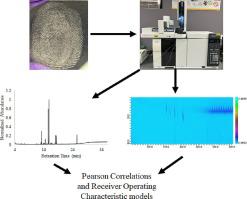Forensic Chemistry ( IF 2.7 ) Pub Date : 2023-08-02 , DOI: 10.1016/j.forc.2023.100521 Jessica Kindell , Candice Bridge

|
In response to the National Academy of Science’s report on Strengthening Forensic Science, many researchers have investigated ways of improving and supplementing pattern-based visual methods for latent fingerprint (LF) analysis. Gas chromatography (GC) has been used to study the initial and aged chemistry of latent fingerprints, along with attempting to statistically asses same source association with donor characteristics. Since LFs are composed of a complex mixture of oil, sweat, and other components, sections within the chromatographic profile that have poor resolution could benefit from better separation of components, thus yielding more associations to the correct source. This study investigates the potential of increased source association using comprehensive two-dimensional (GC × GC) and one-dimensional (1D) gas chromatography-mass spectrometry (GC–MS). Three LFs from a sample of thirteen volunteers were collected, derivatized with boron trifluoride–methanol (BF3-MeOH), and analyzed via 1D GC and GC × GC–MS. The statistical strength of source association was performed by evaluating the log likelihood ratios (LLRs) obtained from the intra- and inter-personal pairwise Pearson correlation comparisons (PCCs) and using the normal and kernel density comparison R functions. The 1D GC method provided stronger same-source association due to high intra-personal PCC values; however, lower inter-personal PCCs were acquired from GC × GC. Higher area under the curves (AUCs) and LLR calibration were computed for the 1D GC PCCs. Conversely, poor statistical calibration and discriminating power were obtained for both 1D GC and GC × GC methods when assessing the LLRs despite having high AUCs.
中文翻译:

通过 1D GC 和 GC × GC-MS 确定潜在指纹化学的错误率和相似性
为了响应美国国家科学院关于加强法医学的报告,许多研究人员研究了改进和补充基于模式的潜在指纹 (LF) 分析视觉方法的方法。气相色谱 (GC) 已用于研究潜在指纹的初始和老化化学,并尝试统计评估相同来源与供体特征的关联。由于 LF 由油、汗液和其他成分的复杂混合物组成,因此色谱图中分辨率较差的部分可以受益于更好的成分分离,从而与正确来源产生更多关联。本研究探讨了使用综合二维 (GC × GC) 和一维 (1D) 气相色谱-质谱 (GC-MS) 增强源关联的潜力。从 13 名志愿者的样本中收集了 3 个 LF,并用三氟化硼-甲醇 (BF3 -MeOH),并通过 1D GC 和 GC × GC-MS 进行分析。源关联的统计强度是通过评估从个人内部和个人之间的成对 Pearson 相关比较 (PCC) 获得的对数似然比 (LLR) 并使用正态密度和核密度比较 R 函数来进行的。由于个人内部 PCC 值较高,1D GC 方法提供了更强的同源关联;然而,较低的人际 PCC 是从 GC × GC 中获得的。针对 1D GC PCC 计算出较高的曲线下面积 (AUC) 和 LLR 校准。相反,尽管 AUC 较高,但在评估 LLR 时,一维 GC 和 GC × GC 方法的统计校准和判别能力较差。



























 京公网安备 11010802027423号
京公网安备 11010802027423号